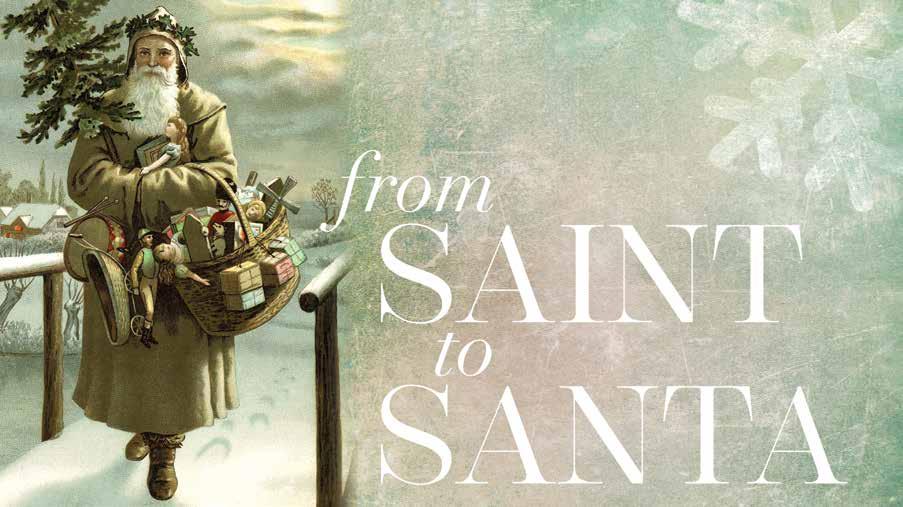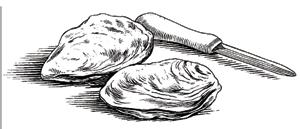
12 minute read
From Saint to Santa
Whether you think of him as St. Nick or as Santa Claus, that rotund and jolly white-bearded man is the embodiment of the spirit of giving at Christmas. So who exactly is the man in the red suit?
It all starts with St. Nicholas. According to historic accounts, Nicholas was born around 280 A.D. in the Greek village of Patara, now located in modern-day Turkey, and was raised by wealthy parents to be a devout Christian. Left a young orphan when they died in an epidemic, Nicholas gave away his entire inheritance, became a monk, and traveled the countryside helping those who were sick and in need. Much admired for his piety and acts of charity and kindness, St. Nicholas became Bishop of Myra, and was the subject of many legends over the decades. He was widely known as a protector of children and sailors until his death on December 6, 343 A.D. To this day St Nicholas continues to be venerated by Catholics and Orthodox and honored by Protestants as a model of compassionate life. By the Renaissance, St. Nicholas was the most popular saint in Europe.
St. Nicholas’ feast day, celebrated on the anniversary of his death, kept alive the stories of his goodness and generosity. In much of Europe, December 6th is still the main day for giftgiving. But in Belgium, instead of a reindeer and sleigh for transportation, St. Nicholas arrives via steamship from Spain to ride a white horse to deliver gifts. In the Netherlands, St. Nicholas is celebrated the evening before the feast day by sharing candies, initial letters made of chocolate, small gifts, and riddles. Carrots and hay are placed in Dutch children’s shoes for St. Nicholas’ horse in hopes that they’ll be exchanged for small gifts.
When the first Europeans arrived in the New World, they brought their love of St. Nicholas with them. On December 6, 1942, Columbus named a Haitian port for St. Nicholas. Closer to home, the Spaniards first established Jacksonville as St. Nicholas Ferry. Since the Protestant Reform tried to stamp out the importance of saints, the first colonists, who were primarily Puritans, did not commemorate or celebrate St. Nicholas. After the American Revolution, however, New Yorkers proudly resurrected the nearly-forgotten Dutch roots of their colony. (continues)

At the New York Historical Society’s annual meeting in 1804, member John Pintard distributed woodcuts of St. Nicholas which featured stockings filled with toys and fruit hung over a fireplace in the background of the image. It is the Dutch nickname “Sinter Klaas,” short for Sint Nikolaas, from which the name “Santa Claus” evolved. In 1809, Washington Irving contributed to the popularity of Sinter Klaas stories when he referred to St. Nicholas as the patron saint of New York in his book, The History of New York. As the popularity of Sinter Klaas grew, the attire of this “rascal” ranged from descriptions of a red hooded cloak, to a blue three-cornered hat, red waistcoat, and yellow stockings, to a broad-brimmed hat and a “huge pair of Flemish trunk hose.”
However, in the church, Christmas had been eliminated as a holy season. December 25 was regarded as a day for normal business, without any religious significance. Christmas in the early 19th century was characterized by drunken revelry by mobs celebrating the harvest’s end and leisure time from work. The cultural changes of the times and attempts to “domesticate” the holiday and shift the focus to children and family are captured well by Charles Dickens in A Christmas Carol.
It was Episcopal minister Clement Clarke Moore’s well-known 1822 poem An Account of a Visit from St. Nicholas, (or The Night Before Christmas) that can be credited with tying together St. Nicholas with our modern-day idea of Santa Claus and the Christmas holiday. The poem’s widespread popularity spread the image it evoked of this “jolly old elf” flying from house to house on Christmas Eve in a sleigh pulled by flying reindeer to deliver presents to deserving children. New life was breathed into the holiday as a family gift-giving celebration and stores began to advertise using Santa. The first likeness of our “modern Santa” is a cartoon by Thomas Nast that appeared in Harper’s Weekly in 1881. The cartoon, inspired by Moore’s poem, depicted Santa as a happily rotund white-bearded fellow with a sack full of toys. Nast continued his Santa drawings through 1886, and Santa’s bright red and white fur-trimmed suit, his North Pole workshop and elves, and his wife, Mrs. Claus, can all be attributed to him.

In an ironic twist, it was this newfound popularity of Christmas that returned the holiday to churches. Though this “secular” Santa had been stripped of the religious mantle of the saint from whom he had evolved, the influence of Dutch and German immigrants who loved Christmas, the writings of Moore, Irving and Dickens, and church musicians embracing the singing of carols, all served to bring Christmas observances back into the lives of churchgoers, making it once more acceptable in the church.
Today, Santa is virtually synonymous with Christmas. From the holiday parades to commemorative Coca-Cola bottles to the Rankin/ Bass TV classics like Santa Claus is Coming to Town that we all love, Santa is everywhere. But, like Buddy the Elf, we’re awfully fond of the big guy and proud to say “WE KNOW HIM!” and we hope that there’s never really a year without a Santa Claus!

Illustration by Thomas Nast, from Harper’s Weekly,1881



The St. Simons Land Trust has been hosting its annual Oyster Roast since the organization was founded in 2000. This January will mark the 19th year of one of the community’s favorite gatherings on the Georgia Coast. This special night benefiting our island home is made possible by the participation of more than 50 local restaurants and vendors, 17 corporate sponsors, presenting sponsor Parker’s Convenience Stores, and a legion of volunteers. Since this 19th annual event will be held on January 19, in 2019, we’ve come up with – you guessed it – 19 good reasons why you should attend.
Of course, for many people the OYSTERS are Reason #1 to come out! Nearly 1,500 lbs. of sweet, fresh, plump, juicy oysters will be roasted over hot coals and tossed out by the hundreds for everyone to enjoy. You know that oysters are delicious, but did you know that they’re also good for you? Rich in B-12 vitamins, these crazy-looking mollusks provide more energy than a shot of caffeine. They boost immune systems, and they increase testosterone and sexual health. So, eat up!
And it’s not just the delicious meat of the oyster that makes them a valuable resource, Reason #2 is OYSTER SHELLS. For generations coastal residents have recycled oyster shells to make tabby, one of the most durable building materials ever created. Made with a combination of burned oyster shells that create lime, the shells are mixed with wood ash, sand, and water. Tabby concrete was used by Spanish explorers who settled the coastal regions of the southeastern United States and was also a major (continues)


construction material during the plantation era. Most of the ruins from that period, including the former slave quarters at Gascoigne Bluff, are made of tabby.
Today, one of the most important uses of discarded oyster shells is the creation of living shorelines, such as the one at Cannon’s Point Preserve. The reused shells, combined with wetland plants, create breeding and feeding grounds for aquatic life such as shrimp, crabs, and shorebirds. Building up the shores of our waterways with recycled oysters shells also helps to reduce erosion and protect coastal areas from flooding and storm damage.
This year, all oyster shells will be sent to Honey Creek Episcopal Camp and Retreat Center at Dover Bluff to help reconstruct the bluff that was severely damaged during Hurricane Irma. Their dock, environmental education building and chapel need protection from further erosion and your oysters will help do just that.
No matter how many oysters you eat on January 19, you can rest assured that those rough and knobby oyster shells, after being dried for six months, will be used to help keep our shorelines alive and our salt marshes clean, pure, and protected.
THE THREE Bs are Reason #3. That’s Beer, Barbeque, and Beans. These three things are perfect to accompany the main dish at any oyster roast. When award-winning, world-famous Southern Soul Barbeque provides the Q, you know it’s going to be delicious! And when the brisket is paired with Southern Eagle beer and the baked beans from Porch, you’ve really got something special. The LOW COUNTRY BOIL provided by Bob Thompson and 1%-for St. Simons partner Creative Printing is Reason #4. Every year, Bob and his friends pull up a motor home at Gascoigne Bluff and fill his seasoned pots with fresh Wild Georgia shrimp, sausage, potatoes, and corn, to make the best Low Country Boil on the coast. What a feast!
“THE RULE OF R” is a good Reason #5. Oysters, it is said, should only be eaten during the months that have an “R” in the name: SeptembeR through ApRil. But the very best month for oyster roasting is in JanuaRy, when the weather is cool, briny breezes blow off the marsh and Frederica River, and oysters are at their peak. Don’t forget the date: JanuaRy 19!

an adult education component to the evening. Reason #6 for attending is LEARNING how to properly shuck an oyster without slicing your hand. Oyster Roast veterans are happy to share their shucking skills (and maybe an oyster or two) with you.
We all love to ACT A LITTLE CHILDISH sometimes. This opportunity is our Reason #7! As an adult, where else is it acceptable to wear a bib amongst your friends? At the Oyster Roast, a bib is not only accepted, it may be required!
The NEARLY 50 OTHER RESTAURANTS and food vendors are Reason #8. Sea Island’s fried chicken, mac and cheese, and chowder. Saint Andre triple cream brie in pastry with sundried tomato jam. From humble to haute cuisine, you can sample it all. Okay, it’s not just about the food, right? There’s also MUSIC AND DANCING. That’s Reason #9. Jamie Renee & The Walkers will keep you entertained with their jazzy, folksy vibe. Strings, drums, piano, sax, and Jamie’s sweet Southern voice are perfect on a bluesy winter night.
Reason #10 is that it’s THE 19TH YEAR! The first Oyster Roast in 2000 was intended as a Land Trust celebration for 20 people, and the event at Village Creek Landing drew a crowd of nearly 100. One of the organization’s founders, Frances McCrary, spent much of the night running out to buy more food. Every year since, the event has grown, and grown, with more than 1,000 guests attending in January 2018.
Gascoigne Bluff is not just a slip of land tucked up under the northern side of the Torras Causeway on St. Simons Island’s western edge. There’s HISTORY there along the Frederica River, and that’s Reason #11. As you eat, drink and make merry, you can envision the Native American campground that used to be on the site. Or the Franciscan monastery once called San Buenaventura. The bluff was named for Captain James Gascoigne, a commander of the sloop-of-war, HMS Hawk.
It’s almost impossible to think about that bluff without also thinking of Reason #12, its LIVE OAKS. These magnificent, natural works of art contain some of the strongest wood in the world. Timber harvested from 2,000 Gascoigne Bluff live oak trees was used to build the USS Constitution (aka Old Ironsides) and five other US Navy frigates.
And then there’s the spectacular sunset over the rivers and Marshes of Glynn. (continues)

Few sights are more beautiful than Reason #13. Sometimes those SUNSETS are bright red. Other times they’re orange, purple and pink, or blue. Whatever the hue, the setting sun over the Frederica River from the bluff is breathtaking and a reminder that the Golden Isles are a gift.
STARRY NIGHT. Not just a well-known Van Gogh painting, it’s also Reason #14. And even if the stars aren’t out, the Malone Electric twinkly lights hanging from the oaks and mixed among the moss add to the romance of the evening.
Romance brings us to Reason #15: DATE NIGHT! You might be calling the sitter, or you might be strolling under the stars with your love of 50 years. No matter your age or how long you’ve been together, there’s no better date night of the year. We’ll provide the food, the drink, the atmosphere, and the entertainment. You just provide each other.
And WHAT A DEAL! Reason #16 is all about the bang you get for a night on the Bluff. It’s all of the above and more for only $60 (for SSLT Members) or $85 a ticket for nonmembers. And if you REALLY love a deal, but you’re NOT a current member, join the Land Trust by December 15 and take advantage of the NEW Member DISCOUNT of only $50 a ticket. (Special Discount is for $100 memberships or higher and there is a limit of two tickets at this special price with each new membership.) Get your tickets online at sslt.org before they sell out!
Everyone loves a hero, and the Oyster Roast has 100 of them for you! Our VOLUNTEERS are Reason #17 and you can easily spot them wearing their red aprons. Most will have been working on the Roast for nearly a year. They do everything from cooking and pouring wine, to setting up tables and chairs, to decorating and stringing lights, to selling tickets, directing traffic, shucking oysters, and cleaning up. By the end of the night, you’ll know why “volunteers” is really understating their title.
Sometimes we all have FOMO (Fear of Missing Out). Attending the Oyster Roast is a perfect cure and that’s Reason #18. Don’t give in to FOMO on January 19. Join the others who wouldn’t miss one of the best-loved community events on the Georgia Coast.
We promised you 19 reasons, but the truth is that we think there are unlimited reasons to attend the Oyster Roast. The last we’ll share and best and most important reason of all is because you love St. Simons Island and you want to help ensure that it’s PRESERVED, PROTECTED, AND CONNECTED FOREVER!
COSMETIC & FAMILY DENTISTRY
Highly Recommended. Highly Referred. Accepting New Patients.
912.638.9946 300 Main St. #102 bryandentalssi.com













